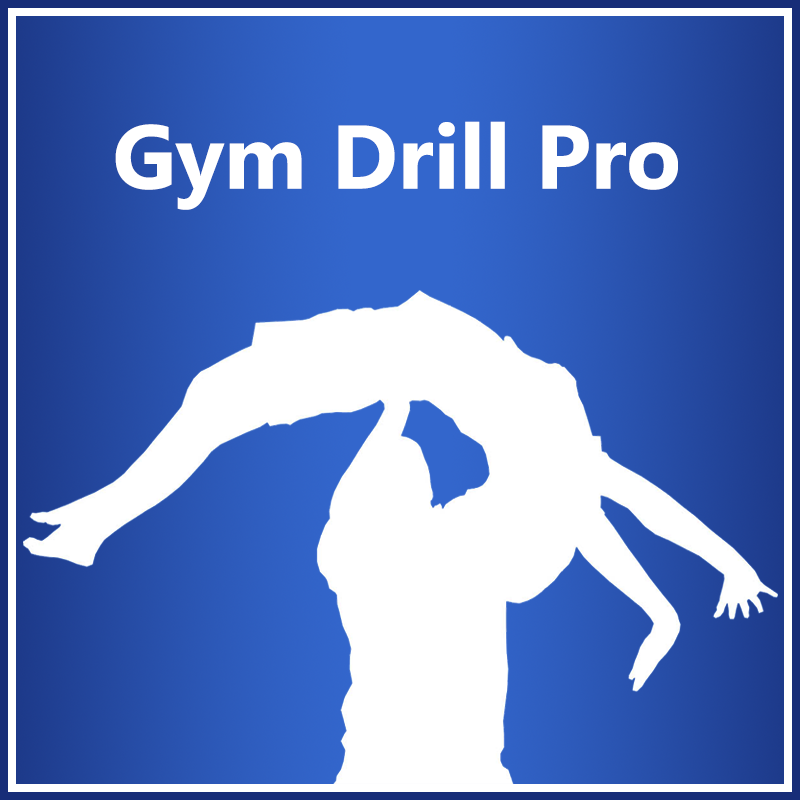

The rings, also known as steady rings or still rings (in contrast to flying rings), is an artistic gymnastics apparatus and the event that uses it. It is traditionally used only by male gymnasts, due to its extreme upper-body strength requirements. Gymnasts typically wear ring grips while performing on the rings. The apparatus consists of two rings that hang freely from a rigid metal frame. Each ring is supported by a strap, which in turn connects to a steel cable that is suspended from the metal frame. The gymnast, who grips one ring with each hand, must control the movement of the rings. An exercise on rings consists of swing, strength and hold elements. Generally, gymnasts are required to fulfill various requirements including a swing to held handstand, a static strength hold, and an aerial dismount. More experienced gymnasts will often perform more than one strength element, sometimes swinging into hold positions or consecutively performing different holds. (Wikipedia)
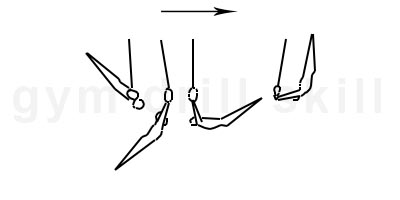
At the highest point in the back swing, the shoulders should be extended with the rings going slightly sideways. The body should be in an arched position. From the top of the swing, continuous shoulder extension toward the bottom of the swing must be maintained. This helps the gymnast maintain the arched body position until the bottom of the swing. At the bottom, the gymnast should kick the legs forward and upward to make their entire body turn over as fast as possible. The gymnast should attempt to kick from their upper chest at the bottom. Shoulder should remain extended and stay down until the entire body turns over completely. The rings should be pushed backward when the gymnast’s feet are pointed towards the ceiling. The rings should turn parallel (wrists facing one another). The rings should not go sideways during this portion of the swing. The final position is a higher point of the front swing, where the body should be in a slight hollow position with arms tight and parallel. The head should be neutral with the gymnast maintaining backward pressure on the rings. From the highest point of the front swing starts the backswing. The body should swing down in a hollow position without losing pressure on the rings. At the bottom, the gymnast should initiate a strong kick off their heels. During the turnover phase, the head should stay down to facilitate a stronger heel lift. Shoulders should remain low. When their heels have risen and their toes are directed upward toward the ceiling, the rings can be slightly open, the head will be slightly elevated as well. The final position of the backswing is arched. VERY IMPORTANT: In the backswing, do not pull down on the rings. The leading motion of the move is the kick back with the heels.
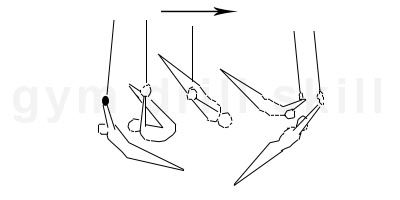
The dislocate skill is an excellent exercise to practice giant swings. Ideally, a disclocate is done with enough height and pressure on the rings so that the gymnast is able to pass through handstand above the rings. There are a few variations and progressions of the dislocate skill. The first (and easiest) is the piked dislocate, followed by the stretched dislocate and eventually giant swing. Regardless of the variation, the body should stay hollow throughout the majority of the skill until reaching the vertical position. Once the gymnast reaches this position, they should straighten their body shape slightly but avoid significant arching. The gymnast’s head should remain neutral or down in order to avoid arching from the upper back and to help maintain more pressure on the rings as they pass through vertical. As the gymnast finishes the shifting from their shoulders, they should push the rings forward and lead from their chest as they reach the bottom of the swing. At this point, they can begin to arch through the bottom of the swing in order to kick their legs and hips for acceleration. The athlete should be very familiar with maintaining a candlestick body shape and keeping pressure on the rings. A common mistake that many gymnasts make when attempting the dislocate for the first time is arching their body as they pass through vertical. This can lead to a lack of control, height, and pressure on the rings. This can be a difficult habit to break and for this reason, it’s important to emphasize the proper technique when first learning the skill. Spotting and holding the gymnast as they pass through vertical can be an effective method in teaching them the correct body positions.
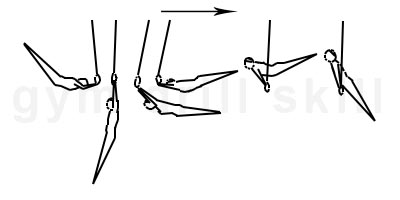
The gymnast should perform a high amplitude backswing. At the bottom the gymnast should kick strong with their heels, pressing down from their shoulders. Their head should stay in a neutral position. When their legs are over horizontal, the gymnast should move their arms sideways with downward pressure on the rings, performing a back circle. After completing the circle, the gymnast should keep their arms by their sides and hold front support on the top of the rings.
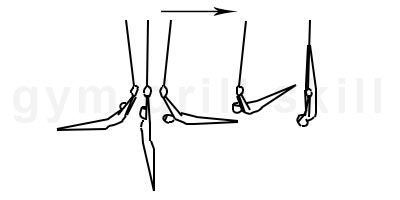
At the highest point in the back swing, the shoulders should be extended with the rings going slightly sideways. The body should be in an arched position. From the top of the swing, continuous shoulder extension toward the bottom of the swing must be maintained. This helps the gymnast maintain the arched body position until the bottom of the swing. At the bottom, the gymnast should kick the legs forward and upward to make their entire body turn over as fast as possible. The gymnast should attempt to kick from their upper chest at the bottom. Shoulder should remain extended and stay down until the entire body turns over completely. The rings should be pushed backward when the gymnast’s feet are pointed towards the ceiling. The rings should turn parallel (wrists facing one another). The rings should not go sideways during this portion of the swing. The final position is a higher point of the front swing, where the body should be in a slight hollow position with arms tight and parallel. The head should be neutral with the gymnast maintaining backward pressure on the rings. From the highest point of the front swing starts the backswing. The body should swing down in a hollow position without losing pressure on the rings. At the bottom, the gymnast should initiate a strong kick off their heels. During the turnover phase, the head should stay down to facilitate a stronger heel lift. Shoulders should remain low. When their heels have risen and their toes are directed upward toward the ceiling, the rings can be slightly open, the head will be slightly elevated as well. The final position of the backswing is arched. VERY IMPORTANT: In the backswing, do not pull down on the rings. The leading motion of the move is the kick back with the heels.
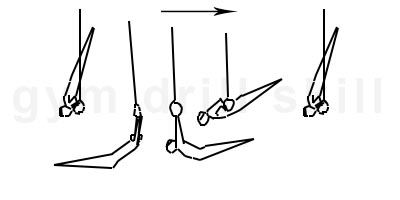
The forward baby giant is usually learned prior to attempting a full giant swing. This skill helps the gymnast understand how to push down on the rings and increase the amplitude of the swings. It also helps the athlete learn to bail in a hollow body and maintain backward pressure on the rings. These concepts are important so that the gymnast gets a full range of motion through the bottom of the swing. The skill begins in a shoulder stand. As the gymnast falls back, the arms push down on the rings in order to create a bigger half circle down to the lower vertical. The body is straight and slightly extended. In the back swing, the legs should raise into vertical. The most important move is the “heel drive”. The arms should be parallel and gradually bend while pushing down on the rings. This allows the shoulders to raise at the level of the rings. The skill finishes in a shoulder stand position. During the move the head should be slightly open.
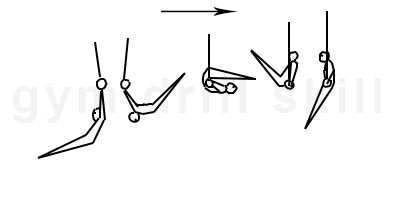
Honma starts with a strong back swing through a tight arch while driving heels very hard up to inverted body with shoulders over the level of the rings. Follows front pike flip, hands are pushing down rings. The ending position is support. Basic skills for Homna are swings, inlocate and kip to support.
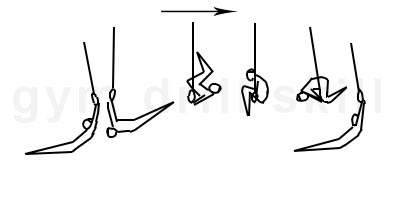
Yamawaki on Still Rings is double front tucked flip with holding the rings. The skill begins from backswing with a very strong kick with heels. First front flip passes through support. The second flip finishes in suspension. During the execution the rings cords are loose.
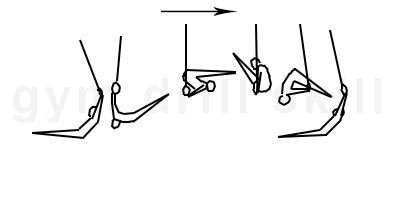
The Jonasson skill is a modification of a Yamawaki on rings, but with tight legs in a piked position. The skill starts with a strong heel drive during the backswing. The legs should reach vertical, the head should be open with the eyes looking at the ground. The arms should be open, similar to an inlocate. Then the gymnast should shift into a kip move. When the body reaches support, the arms provide pressure on the rings in order to perform a forward piked roll to a hanging position. A successive back swing follows. All of the skill should be performed smoothly, the impression should be that the gymnast performs a double front piked flip, holding onto the rings.
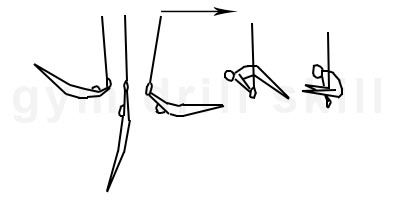
The gymnast should perform a high amplitude backswing. At the bottom the gymnast should kick strong with their heels, pressing down from their shoulders. Their head should stay in a neutral position. When their legs are over horizontal, the gymnast should move their arms sideways with a downward pressure on the rings, performing a back circle. The legs open sideways and when the gymnast raises up to support, they raise in a straddled L-sit outside of the rings. After completing the circle, the arms remain in between the ropes. The legs during the straddled L-sit should be above horizontal.
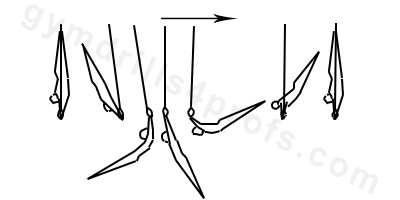
The gymnast should start in a properly executed ring handstand. The gymnast should begin the bail by leaning their heels forward, away from the vertical. They should then push the rings in the opposite direction while maintaining straight arms. They should keep tension on the rings to avoid having a shoulder angle. This will keep the bail long and allow for a higher backswing. Having a hollow body will help the gymnast maintain this pressure on the rings. The gymnast should keep this hollow body throughout the first portion of the bail, this will ensure a smoother swing. The gymnast should then have a strong heel drive and pressure on the rings as they raise their body in the backswing. The gymnast can either keep their arms parallel or widen them as they raise their body to the handstand position. Before attempting this skill, the gymnast should have a strong handstand, swing, and ideally be able to perform inlocates at ring height or higher. Meeting these criteria first will make the front giant much easier.
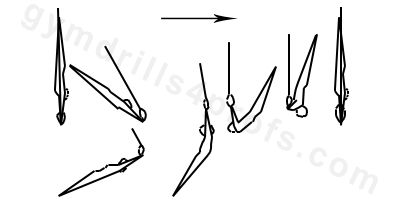
The back giant on rings begins from a properly executed handstand. The bail should begin with the gymnast pushing the rings forward. The gymnast should maintain tension on the rings to reduce slack on the cables, and so that the swing can reach its maximum potential. The body should remain straight throughout the bail, until the gymnast is directly under the rings. At this point, the gymnast should keep a tight arch through the bottom of the swing while maintaining pressure on the rings. The gymnast should then kick their heels upward in a candlestick position as they begin the next part of the back giant. The body should turnover into an inverted vertical position, and the gymnast should put backward pressure on the rings. This will help the body rise into the handstand. The gymnast can push the rings outward to help put more pressure on the rings. The gymnast should finish the back giant in a controlled handstand.

The handstand is a very common skill. It can be static (held), or dynamic, where the gymnast passes through the handstand briefly. A handstand on rings is typically more difficult than other variations. This is because the rings themselves are not static, which means that the gymnast needs to have basic strength requirements in order to balance properly. The arms should be parallel at the width of the shoulders. Also, they shouldn’t touch the cables. The arms and legs should be completely straight. The shoulder angle should be completely extended. During the handstand, the butt and core should be tight, and the head should be in a neutral position with the eyes watching the hands. It’s very important not to watch the hands with the head back, as this can lead to arching through the entire back. The wrists are turned out, which allow the rings to be parallel and even overturned.
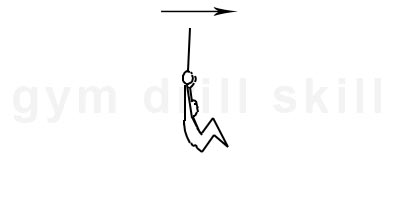
The hanging tucked L-sit is a basic skill and an element of the USAG Boys Level 4 routine. From a straight arm hang, the gymnast lifts their knees to hanging tucked position. The knees are raised as high as possible. The rings are turned out, the wrists should be visible from the side. The shoulders are completely extended. The head is in the middle position.
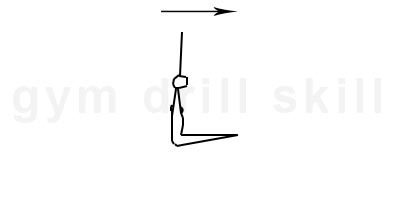
The hanging L-sit is a bonus skill within the USAG Boys Level 4 routine. From a straight arm hang, the gymnast lifts their tight legs to a hanging L-sit. The legs are at horizontal. The rings are turned out, the wrists should be visible from the side. The shoulders are completely extended. The head is in the middle position. The back is straight.
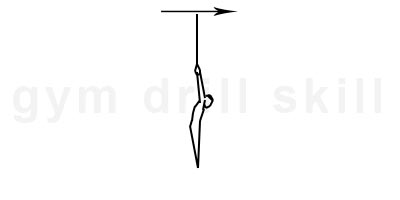
The German hang (skin-the-cat, dorsal hang) is part of the USAG Men's Level 4 Rings routine. This skill can help improve the gymnast’s shoulder flexibility. From an inverted piked position, the gymnast slowly lowers their tight legs to a German hang. The body should be fully straight with maximum extended shoulder flexibility. The gymnast should avoid piking their body, as this prevents the full stretch.
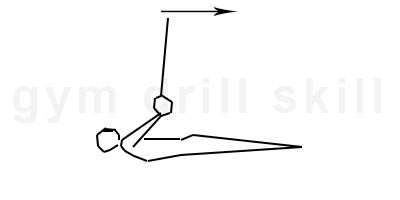
A hanging scale rearways (back lever) is a static hold performed on the rings. The skill is performed by lowering from an inverted hang or inverted piked hang, until the gymnast's body reaches horizontal, facing towards the floor. Performing a back lever requires a certain degree of strength in the chest and shoulders, back and glutei. Minimum requirement according to the code of points is 2 sec. of hold. The body should be fully extended and straight, arms should tight too, with the wrists facing the floor. The head is in the middle position.
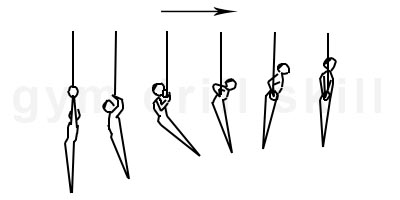
The muscle-up is a strength skill. It starts from a hanging position. The gymnast is allowed to regrip in false grip with tight arms. The gymnast bends their arms, performing a pull-up. When the arms are bent as far as possible, position the arms in front of the chest, the body continues to rise and the rings from the chest move under the shoulders in upper arm support. The gymnast concludes the skill with a dip, extending the arms to the support position. The skill finishes with twisted semi frontal wrists. The rings are turned out and the arms are free from the straps. The rings do not touch the body. The gymnast is in a straight and slightly hollow position. The muscle-up should be performed in one continuous motion. The cables must remain taut (no slack). During the execution, the body is extended and slightly in a hollow position.
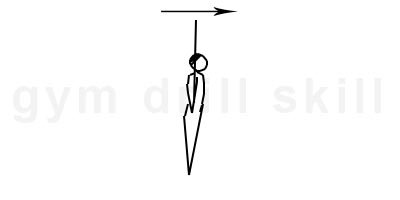
The support skill exists in almost every USAG rings routine (aside from level 4). The arms and body should be straight. A hold of 2 seconds is required. The rings should be turned out and the arms should not touch the cables. The head is slightly raised with the chin up. At first, it may be difficult for the gymnast to turn the rings out if their arms are bent. For this reason, the gymnast should first practice the support hold with tight arms and gradually turn the rings further out as they gain enough strength.

From L-sit on the rings, the hands are at shoulder width. The gymnast raises the butocks in a pike position and simultaneously cleans the shoulder angle. When the legs are already behind the cables, the athlete opens their legs in a straddled L-sit and gradually raises them. The skill finishes in a handstand with the legs together. During the execution of the skill, the legs are completely tight. The skill can be performed with tight and bent arms. The general rule says that the arms should not touch the cables.
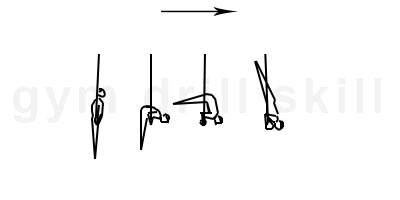
The shoulderstand is very similar to a press handstand. The main difference is that the end of the skill, the body is positioned in vertical with arms bent. To perform this skill, the gymnast should start in support or L-sit and raise their buttocks slowly. They should compress their body into a piked position. When the upper body reaches vertical, the gymnast should lift their legs to the vertical position as well. At the same time, the gymnast should slowly bend their arms until they reach the shoulder stand position. Their head should be slightly open and the gymnast should watch the floor. The gymnast should not touch the cables with any part of their body or upper arms. They should hold this skill in a straight, slightly hollow position.
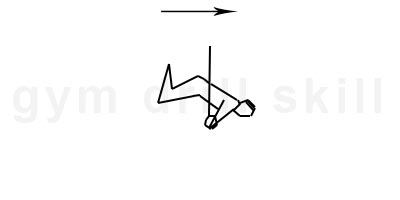
The tucked planche is a level 7 bonus skill. From the L-sit, the gymnast raises their body and bends their legs until the hips are level with the shoulders in a Planche. The rings are turned out. The arms are tight and do not touch the cables. A hold of 2 seconds is required.
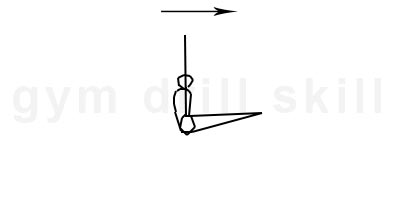
The L-sit is classified as difficulty “A” in the Code of Points. It also exists in the level 5 USAG routine as a bonus skill. Also, some of the elements in group 3 finish in L-sit, such as front uprise L-sit, kip L-sit, and homna L-sit. From support, the gymnast raises their legs tightly up to horizontal. The rings are turned out. The tight arms should not touch the cables. The hips are between the rings. A hold of 2 seconds is required.
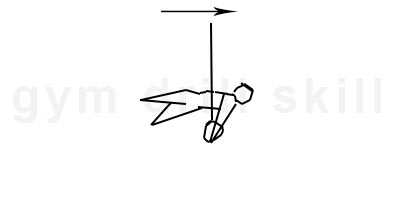
The planche on rings is considered a strength skill in the code of points. It can be performed in straddle and with legs together, as a single skill, or after a swing skill (EG3). For example, the simplest planche skill with a swing is back uprise straddle planche. From an L-sit the gymnast raises their piked body behind the cables and opens their legs. At the horizontal position, they extend their body and hold for 2 seconds. It’s important for their legs, hips, back, and shoulders to all be in line with each other. The rings are turned out. The arms are tight and do not touch the cables. A modification of the skill is with the legs together.
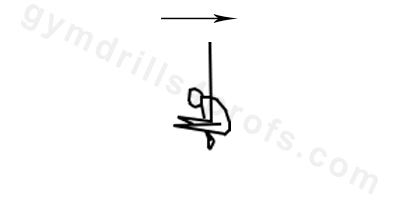
The straddled L-sit is usually performed after a swing skill, for example after back uprise. The rings should be turned out, the wrist should be visible. The legs should be above horizontal, the head is slightly open with the chin up. The cables are behind the arms.
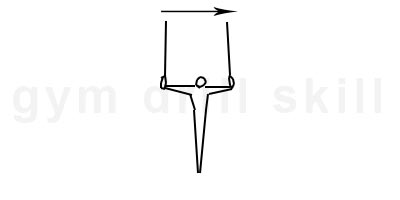
The iron cross is static strength skill, which can be performed after a swing skill too (EG3). The gymnast should be well prepared physically. The most important muscle groups to have succificent strength in are the muscles of the back, chest, shoulders and biceps. The most common swing skills to cross are kip-cross, back uprise-cross, and homna-cross. There are variations of the cross performance too. The cross can be executed with a straight body, in L-sit, or in V-sit. The cross starts from the support position. The rings are turned out. The straight arms should slowly open sideways and the body should lower vertically until the arms reach horizontal. The body should remain straight for the entire skill. A two second hold is required. In the early stages of learning the cross, the athlete could get false grip before attempting the skill. Originally, false grip wasn’t permitted during competitions. Some gymnasts will even open their hands during the performance.
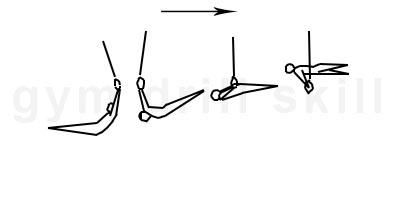
The back uprise is one of the easiest swing-to-hold skills on rings (EG3). But if the planche is performed correctly immediately after the back uprise, the skill becomes pretty difficult. The skill can be seen as a combination of back uprise and cross. It starts from a back uprise, where the gymnast performs a half arm circle with tight arms until they reach front support. When the body reaches the level of the rings, the legs open and the move finishes in a planche. A two-second hold is required. The arms are turned out.
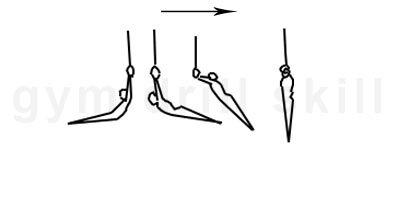
Back Uprise Cross o Still Rings is element group #3 - Swing to Strength Hold Elements. The skill is composed of another two elements - back uprise and iron cross. It is imperative to perform back uprise with tight elbows. For better and fluent transition improve the connection with assistance of a coach.
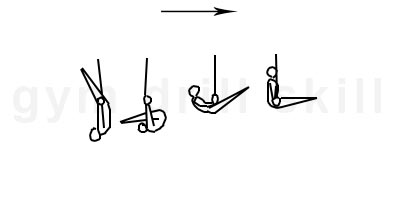
The kip l-sit on rings is one of the new swing-to-hold skills (EG3). It starts in an inverted hang, the gymnast lowers to an inverted pike and with strong, powerful kick opens the body. At the same time, they push down the rings, raise the body over the rings and finish in L-sit support. The athlete should emphasize on having a strong whip upward with the legs, and simultaneously pushing down on the rings. This move will lift the body to the support position. The arms are tight.
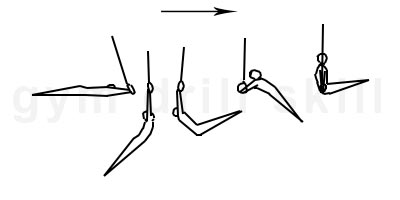
The front uprise L-sit is another EG3 skill. It is relatively easy because the move finishes in an L-sit. It starts from a front swing with a reverse hecht move. After the hanging position, the gymnast should open their hips and kick them upward in the final move of the reverse hecht. Their arms should push down strongly on the rings. This helps to reverse the swing and to raise the athlete onto the rings in a low rear support position. When the body reaches the horizontal, the arms should perform a half circle downward, the hips raise over the rings and the move finishes in an L-sit. The gymnast should emphasize on the strong hips kick upward in the front swing. At that moment the body should be arched. Also, the gymnast should keep in mind that after reaching horizontal, the arm circle from the arms should start. Both moves should be divided, first is the kick from the hips, then goes the arms circle.
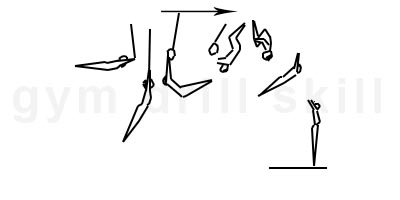
The skill starts from a front swing. From a hang, the gymnast should start bending the legs and pulling up with the arms. The move should be strong and powerful. Bent arms give acceleration to the backflip. The pulling up of the arms gives height to the flip. When the bent knees reach the cables, the athlete leaves the rings and continues the rotation of the body backward. Before landing, the body opens fully and extends.
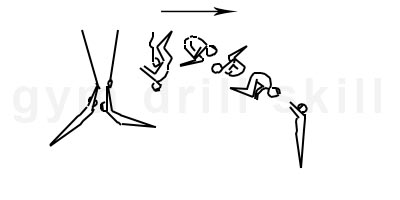
The skill could start from a handstand, tempo giant or from a dislocate. In the front swing after the lower bottom, the gymnast should bend the knees aggressively and pull up with the arms. When reaching the higher vertical and the bent knees are between the cables, the athlete releases from the rings and continues the back rotation of the double somersaults. During the flip the body is in a tucked position, the hands hold the legs. Prior to the landing, they open and fully extend. The gymnast should emphasize on the pull-up move. It will give the skill more height.
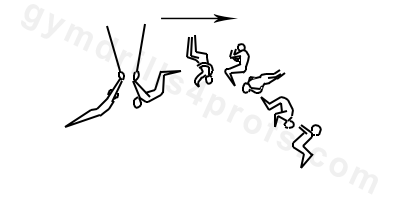
The double back full is a “C” difficulty skill, which covers the minimum requirement of the full credit dismount on rings. It can be performed from a dislocate, handstand or tempo giant. It starts with a strong kick from bent legs after the lower bottom of the front swing. Simultaneously the arms pull up on the rings. At the higher vertical of the front swing, the gymnast releases and finishes the first backflip, at the beginning of the second backflip, the full twist should be initiated. Prior to the landing, the athletes opens the body. During the flip, the body remains in a tucked position. The gymnast should emphasize on the sequence of the moves. First is the pull-up, release, and first backflip. After these motions are executed, the full twist should begin during the second flip.
Integral part of gymnastics coaching process are skill drills. They help gymnasts to learn easier and technically correct. With GYM DRILL PRO you will find variety of ideas for the most the basic gymnastics skills. There are plenty of images with skill drill progressions. It is intended to support explicitly the qualified coaches in their daily coaching business. DO NOT practice without the guidance of proper professionals.